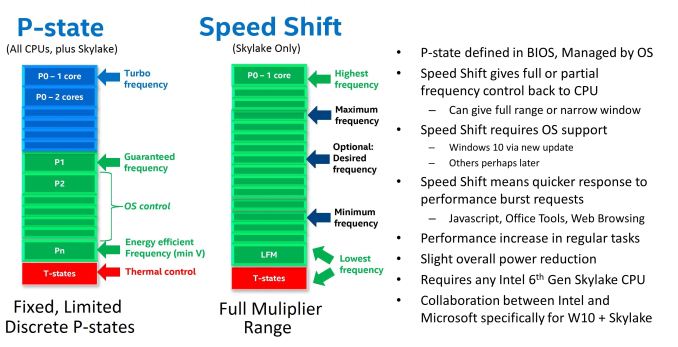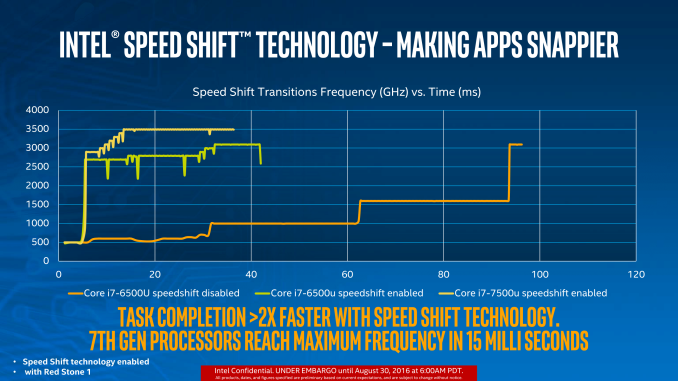The Intel Core i3-7350K (60W) Review: Almost a Core i7-2600K
by Ian Cutress on February 3, 2017 8:00 AM EST7th Generation New Features
One of the big questions regarding the launch of Intel’s 7th Generation of CPUs was around what extra features the new platform brings, especially if there isn’t any clock-for-clock performance improvement. As with our other Kaby Lake reviews, here we explain the main two: Speed Shift v2 and Optane Memory support.
Speed Shift v2
For the Intel’s 6th Generation of processors, Skylake, they introduced Speed Shift (v1). This was a feature that, at a high level, gave control of the voltage/frequency curve from the operating system to the processor. Using a series of internal metrics, such as instruction analysis and frequency, the CPU would automatically adjust the voltage and frequency of the processor as required. This afforded two major benefits: one, with the CPU in control it has access to many more points on the curve compared to the OS which is limited to specific P-states on the processor.
The second benefit is the speed of transition. A processor that can ramp up to a high frequency quickly and then drop down as needed can get through instructions quicker but also save power. Imagine driving a car, and having to wait 60 seconds to change a gear – it’s that sort of analogy.
What Speed Shift v2 does in the Kaby Lake family, compared to v1 in Skylake, is manage those transitions to higher frequency faster. Before Speed Shift, transitions from idle to peak turbo were on the order of 100 milliseconds, and Speed Shift v1 took that to 30 milliseconds (with a good base established within 15). Speed Shift v2 means that peak performance from idle now happens in 10-15 milliseconds total. This means that interactions with the OS, such as touch, or actions that rely on low latency, can occur within a couple of frames on a 60 Hz display.
The benefit of Speed Shift lies a lot in touch devices, which perhaps doesn’t affect the desktop Kaby Lake processors in this review, but also in web interactions. A lot of web work is stop and start, such as scrolling or javascript functions.
There is one caveat however – Speed Shift currently only works in Windows 10. It requires a driver which is automatically in the OS (v2 doesn’t need a new driver, it’s more a hardware update), but this limitation does mean that Linux and macOS do not benefit from it. I would be hard pressed to not imagine that Apple and Intel were not working on a macOS driver, but as yet we have not had confirmation that one exists.
Optane Memory Support
The latest memory technology to hit prime time is Intel and Micron’s 3D XPoint. This is a non-volatile form of data storage that is bit addressable and can be used as DRAM or storage. Despite being at least a decade in the making, and being formally announced in 2014, it is still yet to show up commercially as it is still being developed. Intel plans to create 3D XPoint DRAM that is slightly slower than normal DRAM but both denser (more of it) and non-volatile (keeps the data after power loss, saves power altogether), as well as 3D XPoint Storage that is faster than standard NAND flash, and more configurable. It the scheme of things, we expect the storage based products to hit the market first.
Intel, as far as we can tell, is set to release two main classes of product: Optane DRAM to be pin-compatible with DDR4 and require Optane DRAM enabled processors, and Optane SSDs which should work with any PCIe storage interface. ‘Optane Memory’ however, is something a little different. Based on pre-briefings, Optane Memory is certainly not Optane SSD we were told, but rather a storage cache for mechanical hard-drives. We’ve had this before with NAND flash drives, using Intel’s Rapid Storage Technology, and it seems that Kaby Lake and 200-series chipsets will support a new version of RST for PCIe based storage. But because this is caching drive, such as the 16GB Optane Memory drives in Lenovo’s upcoming notebooks, and not Optane SSD, might lead us to believe that ‘Optane Memory’ drives are not designed to be directly user addressable.
All that being said, Intel has stated that Optane Memory standalone drives should hit the market nearer Q3 for general consumer use, which is more in-line with what we might expect to see with Optane SSDs in the enterprise space.













186 Comments
View All Comments
fanofanand - Friday, February 3, 2017 - link
More to the point, the difference between SSD and HDD is bigger than the difference between Q6600 and i5 7400.BrokenCrayons - Friday, February 3, 2017 - link
I agree with fanofanand on this one. I previously owned a Q6600 and went through the trouble of upgrading to an Athlon x4 860K (recently died) with a lot more/faster RAM (16GB DDR3 2133 vs 4GB DDR2 800). The difference was pretty underwhelming. I've got a Haswell i7 at the office and was moving between it and the Q6600 and the difference in performance was something I noticed, but it didn't leave me feeling like the Q6600 was incomparably slow.Hrel - Friday, February 3, 2017 - link
I'm just gonna point out that anyone saying Intel is in trouble, needs to realize that they have intentionally chosen to not improve CPU performance for several years, instead focusing on improving the integrated GPU. Look how much that's increased! That's in addition to incrementally improving CPU performance.Intel can start channeling their immense resources into improving CPU performance anytime they wish.
Remember, it's in Intel's best interests to keep AMD from going out of business. Outpacing them to the point of making AMD irrelevant would hurt Intel, long term.
CaedenV - Friday, February 3, 2017 - link
I really don't think that Ryzen is going to make Intel dramatically bump up the per-clock efficiency.The real bottle-neck in performance is in the instruction set itself. AMD is behind Intel because they are hitting the same IPC wall. It isn't that Intel hasn't attempted to push the envelope on IPC, it is that it is a universally hard thing to improve at this stage in the game. If it wasn't so difficult then AMD would have stepped up to the task years ago. Even Ryzen isn't going to beat intel in IPC, they are merely going to close the gap a bit, sell for less, and partner with game studios to push bundles.
Die shrinks will continue to make chips more efficient, but unless someone finds a way to dramatically increase clock speed, or come out with a new instruction set that has better IPC while being backwards compatible with x86 (with minimal performance hit, which is the hard part), then I think we are stuck at this level of performance for a long time.
fanofanand - Friday, February 3, 2017 - link
Graphene.BrokenCrayons - Friday, February 3, 2017 - link
Number 2 pencils all over the world unite! :3AndrewJacksonZA - Saturday, February 4, 2017 - link
lolfanofanand - Sunday, February 5, 2017 - link
Think you may confusing graphene with graphite ;)BrokenCrayons - Tuesday, February 7, 2017 - link
Maybe I am.....oooooor maybe the pencils know something we don't!Aerodrifting - Friday, February 3, 2017 - link
There are plenty of games that can bottleneck i5 or even low power i7, Which those benchmarks never show. People who do this sorts of review clearly never play any demanding games, Therefore they are not fit to do a comparison for gaming CPUs.